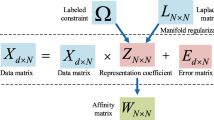Abstract
Self-expression learning methods often obtain a coefficient matrix to measure the similarity between pairs of samples. However, directly using all points to represent a fixed sample in a class under the self-expression framework may not be ideal, as points from other classes participate in the representing process. To alleviate this issue, this study attempts to achieve representation learning between points only coming from the same class. In practice, it is easier for data points from the same class to represent each other than that from different classes. So, when reconstructing a point, if the number of non-zero elements in the coefficient vector is limited, a model is more likely to select data points from the class where the reconstructed point lies to complete the reconstruction work. Based on this idea, we propose Sparse Subspace Clustering with the \(l_0\) inequality constraint (SSC-\(l_0\)). In SSC-\(l_0\), the \(l_0\) inequality constraint determines the maximum number of non-zero elements in the coefficient vector, which helps SSC-\(l_0\) to conduct representation learning among the points in the same class. After introducing the simplex constraint to ensure the translation invariance of the model, an optimization method concerning \(l_0\) inequality constraint is formed to solve the proposed SSC-\(l_0\), and its convergence is theoretically analyzed. Extensive experiments on well-known datasets demonstrate the superiority of SSC-\(l_0\) compared to several state-of-the-art methods.
This work was supported by the National Natural Science Foundation of China (No. 62076164), Shenzhen Science and Technology Program (No. JCYJ20210324094601005), and Guangdong Basic and Applied Basic Research Foundation (No. 2021A1515011861).
Access this chapter
Tax calculation will be finalised at checkout
Purchases are for personal use only
Similar content being viewed by others
References
Zhou, J., Pedrycz, W., Wan, J., et al.: Low-rank linear embedding for robust clustering. IEEE Trans. Knowl. Data Eng. 35(5), 5060–5075 (2022)
Li, X., Chen, M., Wang, Q.: Discrimination-aware projected matrix factorization. IEEE Trans. Knowl. Data Eng. 32, 809–814 (2019)
Lu, J., Wang, H., Zhou, J., et al.: Low-rank adaptive graph embedding for unsupervised feature extraction. Pattern Recogn. 113, 107758 (2021)
Wang, Y., Gao, C., Zhou, J.: Geometrical structure preservation joint with self-expression maintenance for adaptive graph learning. Neurocomputing 501, 436–450 (2022)
Lu, J., Lai, Z., Wang, H., et al.: Generalized embedding regression: a framework for supervised feature extraction. IEEE Trans. Neural Netw. Learn. Syst. 33, 185–199 (2022)
Ng, A., Jordan, M., Weiss, Y.: On spectral clustering: analysis and an algorithm. In: Advances in Neural Information Processing Systems, Vancouver, pp. 849–856. MIT (2002)
Stella, X., Shi, J.: Multiclass spectral clustering. In: Proceedings of the 9th IEEE International Conference on Computer Vision, Nice, pp. 313–319. IEEE Computer Society (2003)
MacQueen, J.: Some methods for classification and analysis of multivariate observations. In: Proceedings of the Fifth Berkeley Symposium on Mathematical Statistics and Probability, pp. 281–297 (1967)
Nie, F., Wang, X., Huang, H.: Clustering and projected clustering with adaptive neighbors. In: Proceedings of the 20th ACM SIGKDD International Conference on Knowledge Discovery and Data Mining, New York, pp. 977–986. ACM (2014)
Lu, J., Lin, J., Lai, Z., et al.: Target redirected regression with dynamic neighborhood structure. Inf. Sci. 544, 564–584 (2021)
Zhou, J., Gao, C., Wang, X., et al.: Typicality-aware adaptive similarity matrix for unsupervised learning. IEEE Trans. Neural Netw. Learn. Syst. (2023). https://doi.org/10.1109/TNNLS.2023.3243914
Elhamifar, E., Vidal, R.: Sparse subspace clustering: algorithm, theory, and applications. IEEE Trans. Pattern Anal. Mach. Intell. 35, 2765–2781 (2013)
Liu, G., Lin, Z., Yan, S., et al.: Robust recovery of subspace structures by low-rank representation. IEEE Trans. Pattern Anal. Mach. Intell. 35, 171–184 (2013)
Lu, C., Feng, J., Lin, Z., et al.: Subspace clustering by block diagonal representation. IEEE Trans. Pattern Anal. Mach. Intell. 41, 487–501 (2019)
Lu, C., Lin, Z., Yan, S.: Smoothed low rank and sparse matrix recovery by iteratively reweighted least squares minimization. IEEE Trans. Image Process. 24, 646–654 (2015)
Lu, C.-Y., Min, H., Zhao, Z.-Q., Zhu, L., Huang, D.-S., Yan, S.: Robust and efficient subspace segmentation via least squares regression. In: Fitzgibbon, A., Lazebnik, S., Perona, P., Sato, Y., Schmid, C. (eds.) ECCV 2012. LNCS, vol. 7578, pp. 347–360. Springer, Heidelberg (2012). https://doi.org/10.1007/978-3-642-33786-4_26
Huang, J., Nie, F., Huang, H.: A new simplex sparse learning model to measure data similarity for clustering. In: Proceedings of the 24th International Conference on Artificial Intelligence, Buenos Aires, pp. 3569–3575. AAAI (2015)
Maggu, J., Majumdar, A., Chouzenoux, E.: Transformed subspace clustering. IEEE Trans. Knowl. Data Eng. 33, 1796–1801 (2020)
Zelnik-Manor, L., Perona, P.: Self-tuning spectral clustering, in: Advances in Neural Information Processing Systems, Montreal, pp. 1601–1608 (2004)
Condat, L.: Fast projection onto the simplex and the \(l\)-1 ball. Math. Program. 158, 575–585 (2016)
Lyons, M., Budynek, J., Akamatsu, S.: Automatic classification of single facial images. IEEE Trans. Pattern Anal. Mach. Intell. 21, 1357–1362 (1999)
Samaria, F., Harter, A.: Parameterisation of a stochastic model for human face identification. In: Proceedings of 1994 IEEE Workshop on Applications of Computer Vision, Sarasota, pp. 138–142. IEEE (1994)
Sim, T., Baker, S., Bsat, M.: The CMU Pose, illumination and expression database of human faces. Carnegie Mellon University Technical Report CMU-RI-TR-OI-02 (2001)
Phillips, P., Moon, H., Rizvi, S., et al.: The FERET evaluation methodology for face-recognition algorithms. IEEE Trans. Pattern Anal. Mach. Intell. 22, 1090–1104 (2000)
Author information
Authors and Affiliations
Corresponding author
Editor information
Editors and Affiliations
Rights and permissions
Copyright information
© 2023 The Author(s), under exclusive license to Springer Nature Switzerland AG
About this paper
Cite this paper
Wang, Y., Zhou, J., Lin, Q., Lu, J., Gao, C. (2023). SSC-\(l_0\): Sparse Subspace Clustering with the \(l_0\) Inequality Constraint. In: Lu, H., Blumenstein, M., Cho, SB., Liu, CL., Yagi, Y., Kamiya, T. (eds) Pattern Recognition. ACPR 2023. Lecture Notes in Computer Science, vol 14408. Springer, Cham. https://doi.org/10.1007/978-3-031-47665-5_12
Download citation
DOI: https://doi.org/10.1007/978-3-031-47665-5_12
Published:
Publisher Name: Springer, Cham
Print ISBN: 978-3-031-47664-8
Online ISBN: 978-3-031-47665-5
eBook Packages: Computer ScienceComputer Science (R0)




